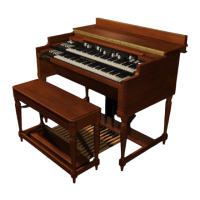
Do you have a question about the Native Instruments B4 II and is the answer not in the manual?
| Brand | Native Instruments |
|---|---|
| Model | B4 II |
| Category | Musical Instrument |
| Language | English |
Provides an overview and context for the B4 instrument.
Details the general software installation process for Windows XP.
Explains how to install the VST plug-in component on Windows.
Guides through setting up the DXi 2 plug-in for compatible hosts.
Covers the installation procedure for the RTAS plug-in.
Steps for installing the B4 II software on macOS systems.
Instructions for installing the Audio Unit plug-in on Mac.
Covers the installation procedure for the RTAS plug-in on Mac.
Explains the purpose and necessity of product authorization.
Step-by-step guide for authorizing the software.
Details online authorization via direct internet connection.
Outlines authorization using a different computer with internet access.
Describes the offline authorization process.
Information on how to get help with product authorization issues.
How B4 II functions as a standalone instrument with audio hardware.
How B4 II integrates as a plug-in within host applications.
Explains the concept of audio latency and its impact on performance.
Setting up the soundcard for standalone operation.
Setting up audio output connections and patching.
Configuration of MIDI input and output interfaces.
Using B4 II as a VST 2.0 plug-in in DAWs like Cubase.
Integrating B4 II as an Audio Unit plug-in in Logic.
Guide for using the DXi 2 plug-in within Sonar.
How to use B4 II as an RTAS plug-in with Pro Tools.
Overview of the manual view for adjusting front panel controls.
The central interface for navigating views and selecting presets.
Explains the different views available for interacting with B4.
Detailed description of the manual view and its controls.
Focuses on the organ view for programming sounds and tonal parameters.
Details the expert view for advanced controls and sound programming.
Introduction to the preset view for organizing and managing sounds.
Explains how to use the presets menu for recalling sounds.
Guide on accessing and utilizing presets within the Manual View.
Steps for creating and saving custom organ sounds as presets.
How to save and share presets with other users.
Organizing and managing the organ sound library via the Preset View.
Using built-in MIDI recordings to test organ sounds.
Managing presets, including list operations and file import/export.
Defining key ranges for controlling different manuals.
How MIDI note velocity and messages affect the B4's sound.
Routing audio signals through B4 for tone shaping.
Mapping MIDI controllers to B4 parameters.
Configuring options like MIDI compatibility and drawbar behavior.
Settings for drawbar behavior and pedal drawbars.
Assigning MIDI channels and transposition for manuals.
Activating the full screen display for distraction-free use.
Controls available in the Manual View for sound creation.
Adjusting the depth and type of vibrato and chorus effects.
Configuring the drawbars for the bass pedal channel.
Details on the drawbars for the lower manual.
Details on the drawbars for the upper manual.
Using percussion switches to add amplification and decay.
Selecting preset banks and individual presets.
Adjusting the speed and acceleration of the rotary speaker simulation.
Using the swell pedal for dynamic volume control.
Configuring the tube amplifier model, drive, and EQ.
Selecting and configuring cabinet models for tonal shaping.
Adjusting virtual microphone placement and levels.
Controlling stereo imaging and tonal balance.
Replacing and selecting different tonewheel generator sets.
Detailed control over percussion volume, decay, and harmonics.
Fine-tuning vibrato and chorus effects with continuous controls.
Adjusting reverb types, time, size, and pre/post settings.
Advanced controls for treble and bass rotor speed and spread.
Detailed settings for the treble rotor speed, acceleration, and spread.
Detailed settings for the bass rotor speed, acceleration, and spread.
Managing microphone spread and distance for stereo effects.
Explains the fundamental principles of drawbar programming and harmonics.
Practical examples and techniques for creating organ sounds with drawbars.
Lists keyboard shortcuts for controlling B4 functions.
Details mouse interactions for parameter adjustment and menus.
Lists books and articles for further learning about Hammond organs.
Recommends artists and recordings for inspiration.
Explores different musical genres and their use of the Hammond sound.
Illustrates the audio signal path through the B4.